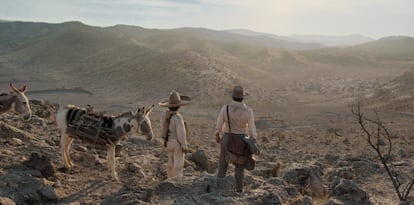Adapt to cinema Pedro Paramoone of the great works of universal literature and spearhead of the renewal of Latin American narrative, is one of those companies doomed to failure. Nothing new: it is also impossible to transfer to the screen Moby Dick, Ulises or the Quixotealthough there are attempts to do so, some of them with indelible flashes.
Of Pedro Paramo There are at least two versions prior to this one, the one from 1967, by Carlos Velo, in whose writing Carlos Fuentes participated, and, 10 years later, the one by José Bolaños, which lasted almost three hours. The main difficulty was always the same: capturing in images a circular time in which the poor souls of Juan Rulfo’s desert live; make an imaginary place real, heir in its own way to Faulkner’s Yoknapatawpha County, in which an afterlife, close to the fantastic, emerges that traps the reader in a spider’s web full of voices and ghosts. Pedro Paramo It is a novel about orphanhood and the search for origin whose legendary beginning —”I came to Comala because they told me that my father, a certain Pedro Páramo, lived here. My mother told me. And I told her that I would come to see him as soon as she died”—opens the version that is now being released by Netflix while the camera dives deep into the earth and into its roots.
Directed by Mexican Rodrigo Prieto —one of the most recognized directors of photography in the industry today, capable of filming in the same course Barbie y The Moon Killers—, this adaptation is written by the Spanish Mateo Gil, who had been considering the possibility of directing it himself for some time. Prieto and Gil make up an interesting tandem for a version that is surprising in its writing, much more attentive to the original form of the work than the two previous adaptations. With this material, Prieto illustrates the complex structure of suspended time and voices swayed by the wind of the novel, but, unfortunately, this care remains in the mere translation, without proposing its own place, which ends up destroying the possibility of a deeper audiovisual reading. Only by being deeply personal could the director have shed light on such a universal work.
A few weeks before the premiere also on Netflix of the series about One hundred years of loneliness (García Marquez always admitted the enormous echo of Pedro Paramo in his work), it seems obvious that this adaptation is not intended to seduce Rulfo’s readers. Nor, we fear, will it attract new followers to his brief work, perhaps because the literalness of the film paradoxically fails to convey the powerful experimental and poetic character of the text, even though it allows the viewer to believe that they have read the novel without having done so. .
Prieto confronts the shadows of Comala’s murmurs, narrated by Juan Preciado, the son who returns looking for his father, with the bright light of the past, in which that sought-after parent is presented as a Ciudadano Kane of the rural Mexican world crossed by his own Rosebud: Susana San Juan, his childhood love. It is that story and its colorful realistic handles (with some unnecessary addition in the form of a half-erotic dream in black and white) that finally take precedence over the rest, reducing the story to its most obvious plot, that impossible love that flies over the totem pole. of the great chief, whose “living resentment” does not fully emerge, although the actor Manuel García Rulfo magnetically embodies the great patriarch.
In the sixties, after writing the feature film The golden roosterscripted by Fuentes and García Márquez, and the experimental medium-length films The dispossession y The secret formulaRulfo expressed his disenchantment with his country’s cinema, calling it “mechanical,” “with cardboard sets.” The new version of his novel does not feel like cardboard – the production design, the visual effects or the soundtrack prevent this – but it is mechanical, with a lustrous color that makes one miss the anthropological mystery of Rulfo’s photographic legacy. and his Rolleiflex camera. In short, a correct set that perhaps for that very reason ends up clashing with the dusty sadness that the poetics of Rulfo and his faceless ghosts transmit.
Pedro Paramo
Address: Rodrigo Prieto.
Interpreters: Manuel García Rulfo, Ténoch Huerta, Ilse Salas, Mayra Batalla, Dolores Heredia.
Gender: drama, Mexico, 2024.
Platform: Netflix.
Duration: 123 minutes.

